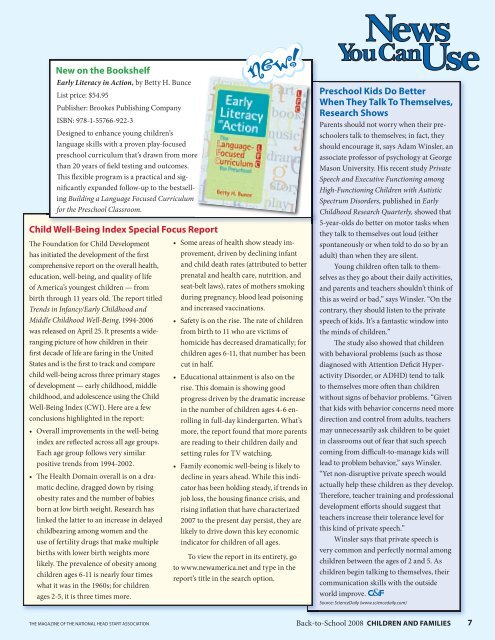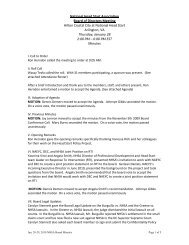New! - National Head Start Association
New! - National Head Start Association
New! - National Head Start Association
Create successful ePaper yourself
Turn your PDF publications into a flip-book with our unique Google optimized e-Paper software.
<strong>New</strong> on the Bookshelf<br />
Early Literacy in Action, by Betty H. Bunce<br />
List price: $54.95<br />
Publisher: Brookes Publishing Company<br />
ISBN: 978-1-55766-922-3<br />
Designed to enhance young children’s<br />
language skills with a proven play-focused<br />
preschool curriculum that’s drawn from more<br />
than 20 years of eld testing and outcomes.<br />
is exible program is a practical and signi<br />
cantly expanded follow-up to the bestselling<br />
Building a Language Focused Curriculum<br />
for the Preschool Classroom.<br />
Child Well-Being Index Special Focus Report<br />
e Foundation for Child Development<br />
has initiated the development of the rst<br />
comprehensive report on the overall health,<br />
education, well-being, and quality of life<br />
of America’s youngest children — from<br />
birth through 11 years old. e report titled<br />
Trends in Infancy/Early Childhood and<br />
Middle Childhood Well-Being, 1994-2006<br />
was released on April 25. It presents a wideranging<br />
picture of how children in their<br />
rst decade of life are faring in the United<br />
States and is the rst to track and compare<br />
child well-being across three primary stages<br />
of development — early childhood, middle<br />
childhood, and adolescence using the Child<br />
Well-Being Index (CWI). Here are a few<br />
conclusions highlighted in the report:<br />
• Overall improvements in the well-being<br />
index are re ected across all age groups.<br />
Each age group follows very similar<br />
positive trends from 1994-2002.<br />
• e Health Domain overall is on a dramatic<br />
decline, dragged down by rising<br />
obesity rates and the number of babies<br />
born at low birth weight. Research has<br />
linked the latter to an increase in delayed<br />
childbearing among women and the<br />
use of fertility drugs that make multiple<br />
births with lower birth weights more<br />
likely. e prevalence of obesity among<br />
children ages 6-11 is nearly four times<br />
what it was in the 1960s; for children<br />
ages 2-5, it is three times more.<br />
• Some areas of health show steady improvement,<br />
driven by declining infant<br />
and child death rates (attributed to better<br />
prenatal and health care, nutrition, and<br />
seat-belt laws), rates of mothers smoking<br />
during pregnancy, blood lead poisoning<br />
and increased vaccinations.<br />
• Safety is on the rise. e rate of children<br />
from birth to 11 who are victims of<br />
homicide has decreased dramatically; for<br />
children ages 6-11, that number has been<br />
cut in half.<br />
• Educational attainment is also on the<br />
rise. is domain is showing good<br />
progress driven by the dramatic increase<br />
in the number of children ages 4-6 enrolling<br />
in full-day kindergarten. What’s<br />
more, the report found that more parents<br />
are reading to their children daily and<br />
setting rules for TV watching.<br />
• Family economic well-being is likely to<br />
decline in years ahead. While this indicator<br />
has been holding steady, if trends in<br />
job loss, the housing nance crisis, and<br />
rising in ation that have characterized<br />
2007 to the present day persist, they are<br />
likely to drive down this key economic<br />
indicator for children of all ages.<br />
To view the report in its entirety, go<br />
to www.newamerica.net and type in the<br />
report’s title in the search option.<br />
Preschool Kids Do Better<br />
When They Talk To Themselves,<br />
Research Shows<br />
Parents should not worry when their preschoolers<br />
talk to themselves; in fact, they<br />
should encourage it, says Adam Winsler, an<br />
associate professor of psychology at George<br />
Mason University. His recent study Private<br />
Speech and Executive Functioning among<br />
High-Functioning Children with Autistic<br />
Spectrum Disorders, published in Early<br />
Childhood Research Quarterly, showed that<br />
5-year-olds do better on motor tasks when<br />
they talk to themselves out loud (either<br />
spontaneously or when told to do so by an<br />
adult) than when they are silent.<br />
Young children o en talk to themselves<br />
as they go about their daily activities,<br />
and parents and teachers shouldn’t think of<br />
this as weird or bad,” says Winsler. “On the<br />
contrary, they should listen to the private<br />
speech of kids. It’s a fantastic window into<br />
the minds of children.”<br />
e study also showed that children<br />
with behavioral problems (such as those<br />
diagnosed with Attention De cit Hyperactivity<br />
Disorder, or ADHD) tend to talk<br />
to themselves more o en than children<br />
without signs of behavior problems. “Given<br />
that kids with behavior concerns need more<br />
direction and control from adults, teachers<br />
may unnecessarily ask children to be quiet<br />
in classrooms out of fear that such speech<br />
coming from di cult-to-manage kids will<br />
lead to problem behavior,” says Winsler.<br />
“Yet non-disruptive private speech would<br />
actually help these children as they develop.<br />
erefore, teacher training and professional<br />
development e orts should suggest that<br />
teachers increase their tolerance level for<br />
this kind of private speech.”<br />
Winsler says that private speech is<br />
very common and perfectly normal among<br />
children between the ages of 2 and 5. As<br />
children begin talking to themselves, their<br />
communication skills with the outside<br />
world improve.<br />
Source: ScienceDaily (www.sciencedaily.com)<br />
THE MAGAZINE OF THE NATIONAL HEAD START ASSOCIATION Back-to-School 2008 CHILDREN AND FAMILIES 7




